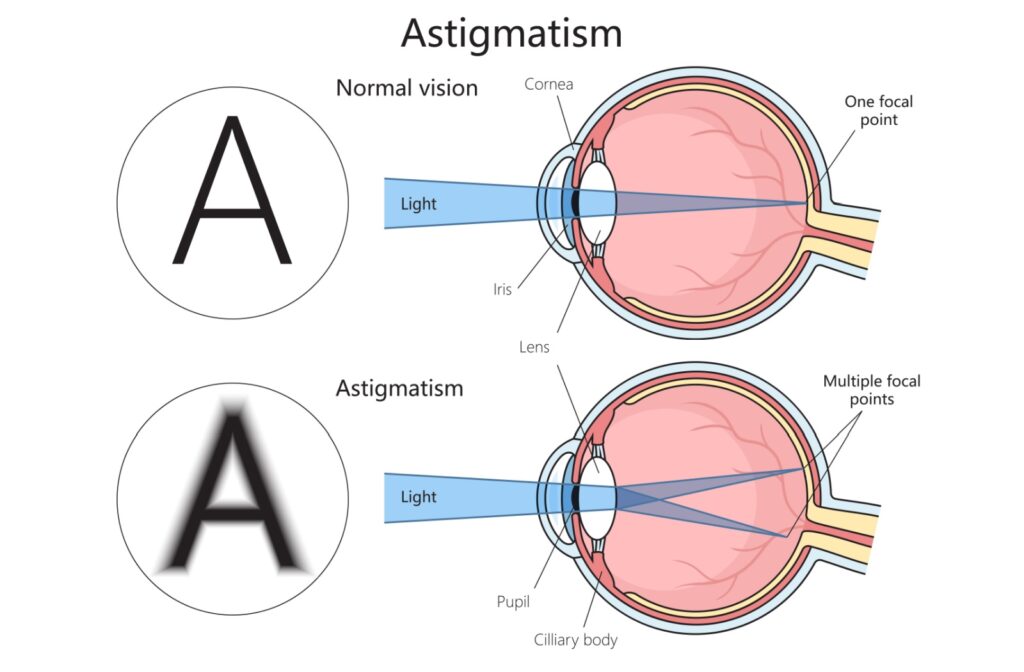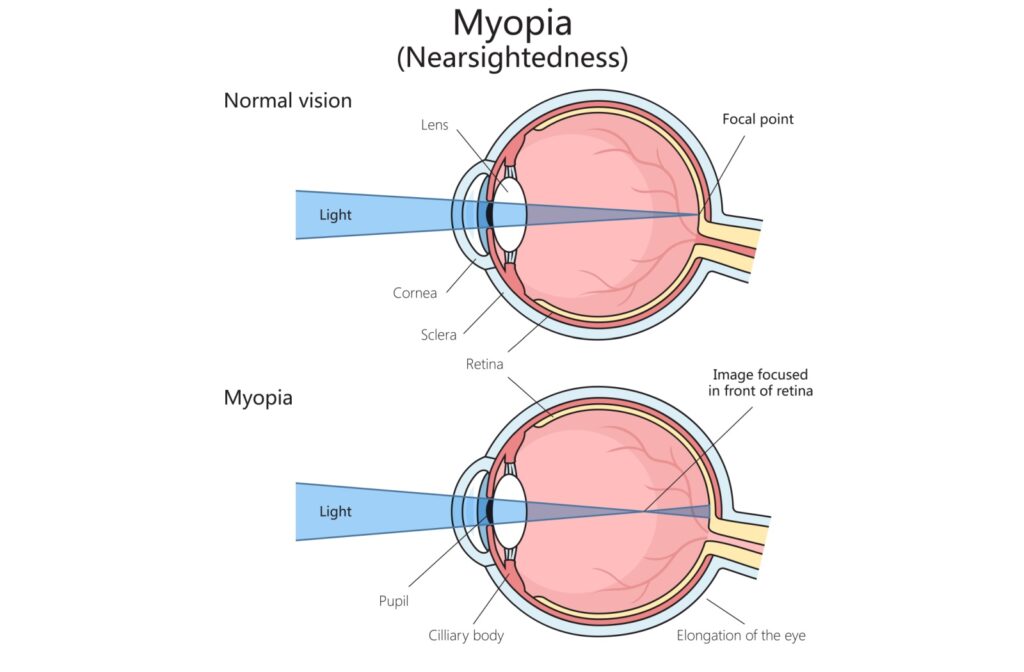You may hear words like myopia and astigmatism and wonder what they mean for your sight. Both are common vision conditions that affect how your eyes focus light, but they do so in different ways.
Think of your eye like a camera trying to capture a sharp image. For clear vision, light needs to focus on one point on your retina. The key difference is that myopia makes distant objects blurry, while astigmatism can cause blurry or distorted vision at all distances.
Myopia & Its Effect on Your Sight
What Is Myopia?
Myopia is also known as nearsightedness. It happens when your eye focuses images in front of your retina instead of directly on it. This makes distant objects look blurry, while close-up objects remain clear.
This can occur if the eyeball is a little too long or if the cornea has too much of a curve. It’s a common refractive error that we see in both children and adults, and for younger patients, there are now effective ways to slow its progression through myopia control.
Common Signs of Nearsightedness
You might notice a few things if you have myopia. These signs can develop slowly over time. Pay attention to how you see things both far away and up close.
- Difficulty seeing distant objects clearly, like road signs or a whiteboard
- Squinting to try and see better
- Headaches or eye strain from the effort to focus
A Focus on Astigmatism
What Is Astigmatism?
Astigmatism occurs when the front surface of your eye (the cornea) or the lens inside has an irregular curve. Instead of being shaped like a basketball, it’s shaped more like a football. This unique shape causes light to focus on more than one point, which can distort your vision.
This can make things look blurry or stretched out at all distances, not just far away. It’s possible to have astigmatism along with myopia or farsightedness. It’s another very common vision condition we see regularly.
Common Signs of Astigmatism
The signs of astigmatism can sometimes be subtle. You may not even notice them without a comprehensive eye exam. Here are a few things you might experience.
- Blurry or distorted vision at any distance
- Eye strain or discomfort
- Headaches, especially after reading
- Trouble with night vision

What to Expect at Your Eye Exam
How We Check Your Vision
A routine eye exam is the best way to identify myopia, astigmatism, or other vision concerns. During your appointment, we’ll guide you through a few simple steps to understand your eyesight and overall eye health.
We may ask you to read from an eye chart to see how clearly you can focus at different distances. Instruments help us measure how your eyes bend light, which shows whether you need correction for myopia, astigmatism, or both. We’ll also check the health of your retina, cornea, and lens to get the full picture.
Certain results can point to common conditions: difficulty reading small print across the room may suggest myopia, while vision that looks stretched, shadowed, or inconsistent at multiple distances often indicates astigmatism.
The process is straightforward and comfortable. Most patients are surprised by how quick and easy it feels.
Why Regular Checkups Are Important
Your vision can change gradually over time, and it isn’t always noticeable right away. Regular checkups allow us to update your prescription as needed and catch small shifts before they affect your daily activities.
These visits are also a chance to ask questions about your eye health. Whether you’d like to understand your prescription better, explore lens options, or discuss any new symptoms you’ve noticed.
Treatment Options for Clearer Vision
Glasses for Clear Vision
Prescription frames and lenses are a reliable way to correct both myopia and astigmatism. Lenses are custom-made to redirect light properly onto your retina, giving you crisp and comfortable sight.
To support your daily comfort, you can choose from options like:
- Anti-reflective coatings to reduce glare from headlights, screens, and bright lights
- Prescription sunglasses that provide UV protection while keeping your vision clear outdoors
- Prism correction in lenses, which can help if your eyes don’t work together as smoothly as they should and you experience double vision or eye strain
Our team will help you select lenses and frames that fit your lifestyle and feel great to wear every day.
Contact Lenses
Contact lenses offer freedom from glasses and clear vision throughout the day. Special toric lenses are designed specifically to correct astigmatism, while a wide range of contacts are available for myopia.
Depending on your preferences, you may benefit from:
- Daily disposables for convenience and easy care
Bi-weekly or monthly lenses for a more cost-effective option with proper cleaning - Rigid gas permeable lenses (RGPs), which can provide sharper vision for certain prescriptions
A contact lens fitting helps us determine the right lens type, size, and material for your eyes. We’ll also show you how to care for them so your eyes stay comfortable and healthy.
Support for Your Overall Eye Health
Address Discomfort & Dry Eyes
Sometimes vision problems are accompanied by eye discomfort. If your eyes often feel tired, scratchy, or watery, you may be experiencing symptoms of dry eye — a common condition with many possible causes.
The encouraging news is that relief is possible. A dry eye exam helps us understand what’s behind your symptoms so we can recommend treatments tailored to you. Often, small changes or simple therapies can make a big difference in keeping your eyes comfortable.
Book Your Eye Exam in Lake Country
Knowing the difference between myopia and astigmatism is the first step. The next is booking a professional eye exam to understand your unique needs and get personalized recommendations for clearer, more comfortable vision.
At Lake Country Optometry, we’re here to help you find the right solution — from stylish glasses to comfortable contacts.Book your appointment today and enjoy clearer, more comfortable vision.




